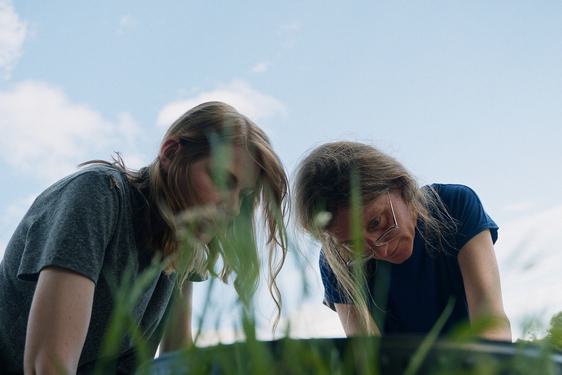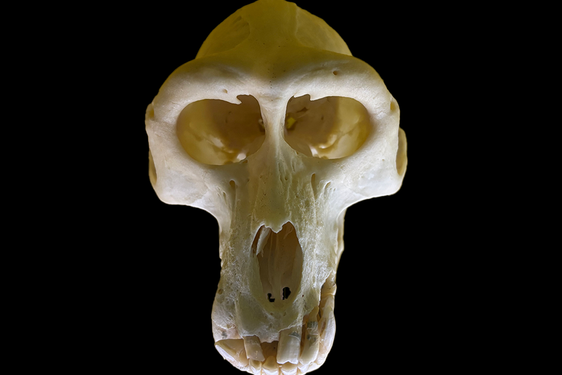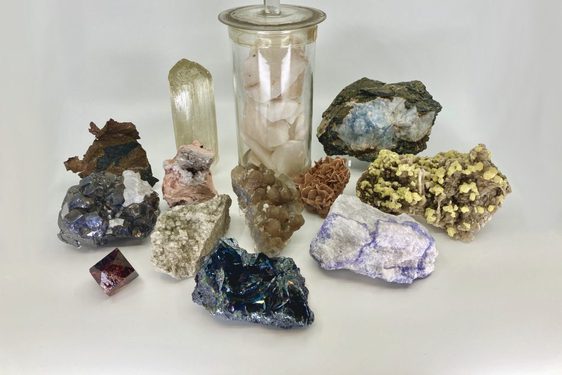
10 species spotted on the grounds of the National Museums Collection Centre
News Story
Our Natural Sciences collections are an invaluable resource for studying biodiversity. They are housed at the National Museums Collection Centre (NMCC) in the north of Edinburgh. Approximately 10 million specimens are protected within our purpose-built stores and studied by curators and visitors within our labs. We actively study biodiversity across Scotland and beyond, but what about the biodiversity on our own doorstep?
Between the buildings at NMCC, there are pockets of greenspace: corridors of grassland that for many years were neatly manicured. In 2021, we redesigned the grass cutting regime, so that it would support the local biodiversity, rather than work against it.
During the growing season we now allow the wild plants to flourish and have a mixture of vegetation heights. Margins and pathways are kept short to ensure good access across the site. We’ve also introduced some additional native wildflowers such as Yellow rattle and new signage notifies visitors to NMCC of the reason for the more natural appearance.
Some areas are left uncut over the autumn/winter, to provide cover and hibernation sites in the cold months. These plots are rotated each year, to maintain plant diversity. The result is a more natural environment, with a tapestry of wildflowers and grasses and a hum of insect life.
We are actively monitoring the biodiversity on site and have recorded more than 400 species so far. Here’s a look at just a few of the species that can be found here, alongside some of the specimens in our collection.
1. Orange-tip butterflies
In the four years that we’ve been recording the biodiversity across the site, we've recorded 16 species of butterfly. That’s almost half of the butterfly species known from Scotland - quite a good selection for an urban green space. One of the most recent additions to our list is the Orange-tip (Anthocharis cardamines), which can be seen flying around the grounds in spring. Since changing our mowing practices, we now have plenty of Cuckoo flower available for them, one of the preferred food plants for their caterpillars. Orange-tips are one of several species of British butterfly whose range in Scotland is expanding, as a result of climate change.
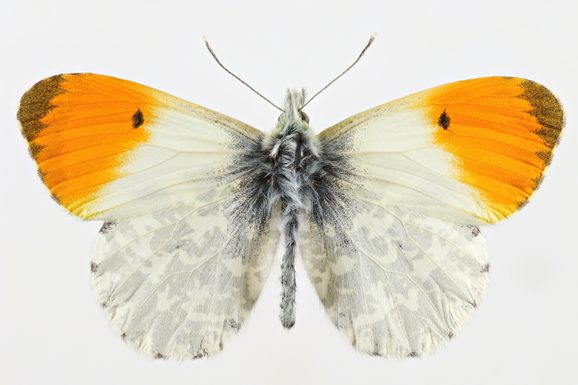
A preserved male Orange-tip specimen from the entomology collection.

A male Orange-tip butterfly nectaring on vetch at the National Museums Collection Centre.
2. Small skipper butterflies
Small but exquisite, a flutter of shimmering orange butterflies appears in summer at NMCC. Small skippers (Thymelicus sylvestris) are one the butterflies to benefit the most from the changes we have made. The areas of grass are no longer neatly manicured, and instead they form a series of small meadows, full of native wildflowers and grasses. The caterpillars of many butterflies feed on grasses, and the favourite food plant of the Small skipper is a grass called Yorkshire fog. This grass is now plentiful, and as a result we now have a very healthy population of these butterflies.

A female Small skipper egg-laying on a grass stem at the National Museums Collection Centre.
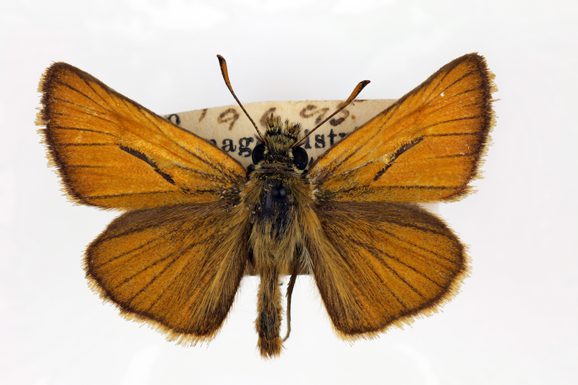
A male Small skipper collected in August 1938 in Swanage, Dorset.
3. Devil's coach horse
Many beetles are predatory and play a vital role in maintaining balance within our ecosystems. Of our 4000 plus species of beetle found in Britain, none are perhaps quite as fierce as the Devil's coach horse (Ocypus olens). This large Rove beetle hunts other invertebrates after dark and is armed with a sharp pair of mandibles to devour its prey.
This beetle is well-known for its defensive stance, if threatened it will curl its abdomen upwards, like the tail of a scorpion. It’s a widespread species, common in gardens and grasslands and has been recorded several times at NMCC.
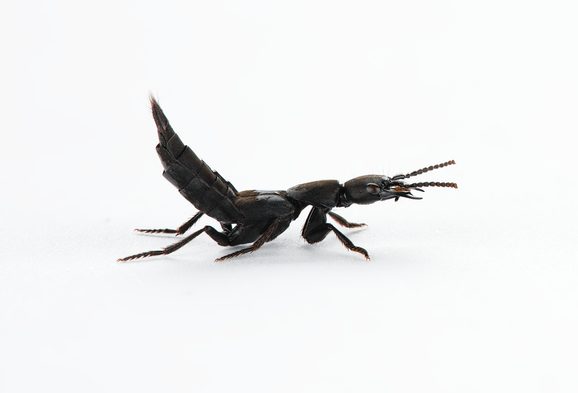
A preserved specimen of Devil's coach horse, mounted in a life-like pose. This specimen can be seen on display in our Adventure Planet gallery.

A Devils coach horse found in September 2024 at the National Museums Collection Centre.
4. Leafcutter bees
Among the many solitary bees that call our site home, are two species of Leafcutter bee: the Patchwork Leafcutter bee (Megachile centuncularis) and Willughby’s leafcutter bee (Megachile willughbiella). The female bees are equipped with a pollen brush on the abdomen for gathering pollen from bramble and thistle flowers, and a pair of strong, serrated mandibles for cutting leaf material. She cuts semi-circular sections of leaf, which she uses for constructing small chambers within in her nest. Layers of leaves form small parcels and in each she lays a single egg and surrounds it with a larder of nectar and pollen, for her offspring to consume.

A female Leafcutter bee (Megachile centuncularis) in action, collecting nest material.
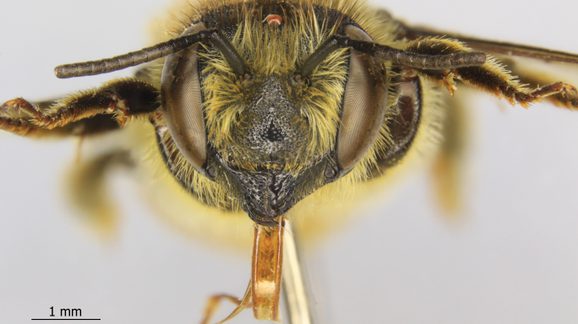
A close-up of the face of one of the Leafcutter bees (Megachile centuncularis) from the collection. Here you can see the strong mandibles used for cutting sections of leaves.
5. Blue tits
Last year we discovered that Blue tits (Cyanistes caeruleus) and Great tits (Parus major) were nesting in some of our lamp posts. We have now installed a selection of nest boxes, to accommodate tits, sparrows and robins. We hope to expand this selection in the future.
A brood of hungry Blue tits will keep the parents very busy, as each chick can eat 100 caterpillars a day. Even more reason to ensure there’s plenty of caterpillar food about.

A Blue tit perched on a lamp post at the National Museums Collection Centre.
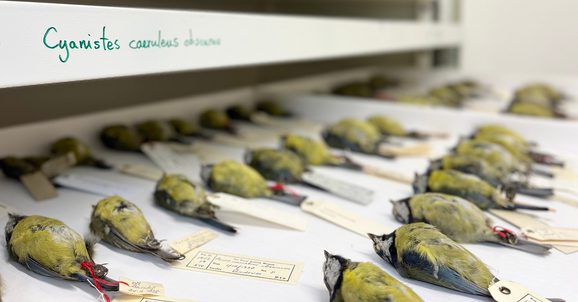
Blue tit study skins in our collection.
6. Garden tiger moth
The Garden tiger moth (Arctia caja) is found throughout Britain, with it’s striking markings on the fore wings and bright orange hind wings marked with blue-black spots, it is unmistakable. Unfortunately, it is one of many moth species whose populations have decreased significantly since the 1980s. This decline is believed to be due to the spraying of herbicides, causing a reduction in the plants the caterpillars rely on, such as Common nettle and Broad-leaved dock. We allow these native plants to grow on the site and each year we find the hairy caterpillars in early spring, and the adult moths in the summer.

Garden tiger moths are recorded each year at the National Museums Collection Centre.
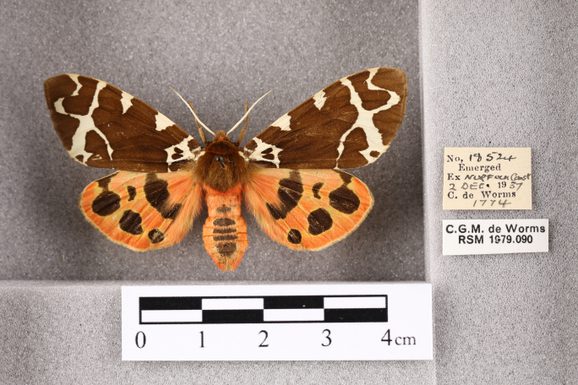
A preserved Garden tiger specimen, revealing the vibrant hind wings of this moth.
7. Foxes
Foxes (Vulpes vulpes) are opportunistic omnivores, which allows them to survive in a wide range of habitats. Did you know you can tell what foxes have been eating by looking at their bones? Research using fox skulls from our collection has directly linked dietary signatures with skull asymmetry. Foxes eating a less natural, less meaty diet - primarily those in our cities - have greater asymmetry, which may reflect greater developmental stress.
What's really interesting is that some foxes within cities have a very natural dietary signature, and these foxes are associated with our larger urban green spaces. When given a chance, urban foxes can utilise natural prey items even in our largest cities.
At NMCC, our low-mow management promotes insects and small mammals, and our camera trap footage shows that the foxes are making use of these natural prey items.
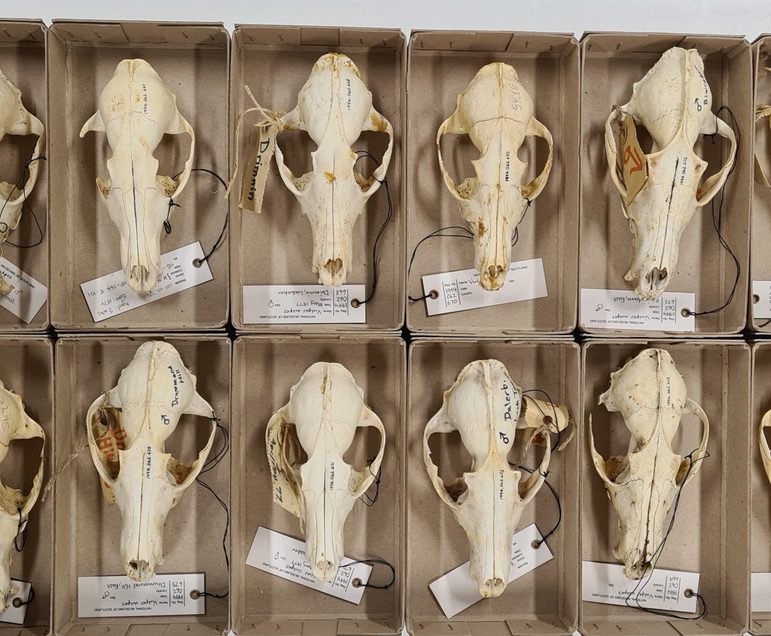
Fox skulls from our Vertebrate Biology collection.
Foxes playing and foraging at the National Museums Collection Centre, captured by one of our wildlife camera traps.
8. Field vole
One of the small mammals we’ve recorded regularly are Field voles (Microtus agrestis). Well adapted to grasslands, they like to eat the leaves and stems of grasses, and make extensive networks of tunnels and burrows under the tall grass.
Voles can sometimes be confused for mice. The key features that help to identify them are their short tails, and round faces with small ears and eyes.

Preserved specimens of Field voles in the collection.
A Field vole recorded by one of our wildlife camera traps at the National Museums Collection Centre.
9. Burnet moths
Burnet moths (Zygaena lonicerae) are some of our most frequently encountered day-flying moths at NMCC. The adults are on the wing in early summer, and on sunny days can be seen visiting a range of flowers, including knapweed and thistles. Their dark wings possess a subtle iridescence, decorated with bright red spots - a warning sign to predators that they contain toxic cyanide. The striking yellow and black caterpillars of these moths overwinter and reappear in the spring to complete their development. By leaving sections of our meadows uncut over the winter period we provide shelter for a variety of animals during the colder months, including Burnet caterpillars.
Image gallery

Burnet moths breed on the grounds of the National Museums Collection Centre; here we have an adult feeding on thistle.

A Burnet moth caterpillar, ready to pupate.

A Burnet moth cocoon, on the stem on an Oxeye daisy.
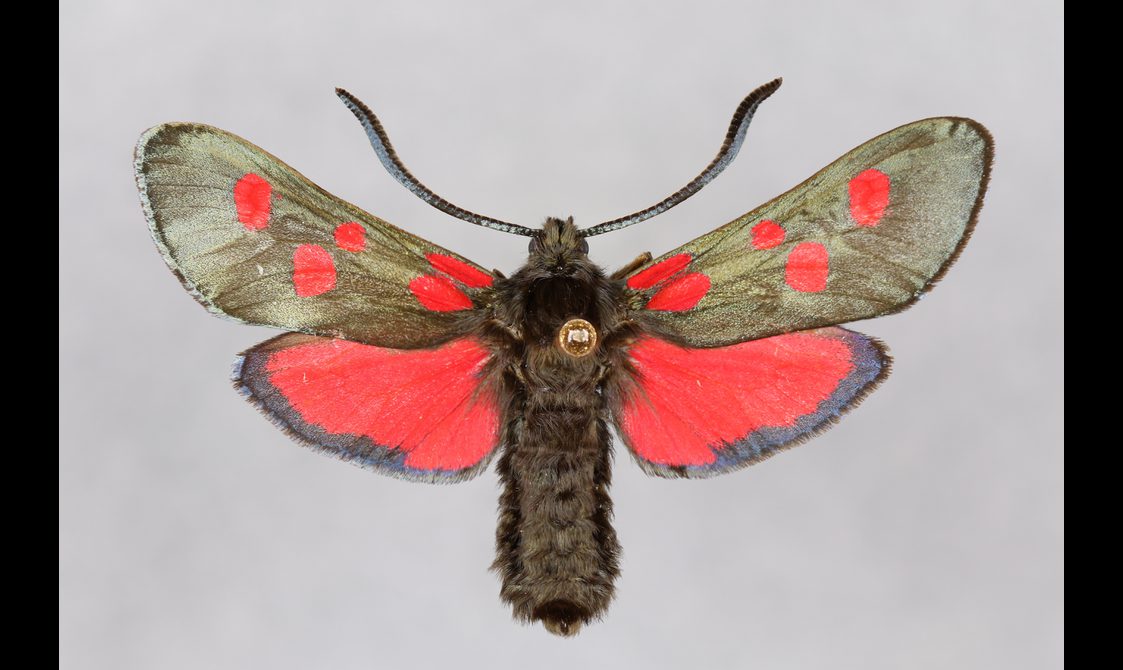
A preserved specimen of Zygaena lonicerae, collected in 1968 from Yorkshire.
10. Finches
Several species of finch have been recorded on the grounds, including Goldfinches (Carduelis carduelis), Chaffinches (Fringilla coelebs), Greenfinches (Chloris chloris) and Bullfinches (Pyrrhula pyrrhula). Finches are generally seed eaters who enjoy a wide variety of different plant seeds, but depending on the season, they may also consume insects, berries and other vegetation. Their diet is nicely illustrated by this unique object in the bird collection: the bird food briefcase. This beautifully crafted case was donated to the natural sciences collection in 1929. Inside, it displays the wild plants & seeds eaten by British finches.
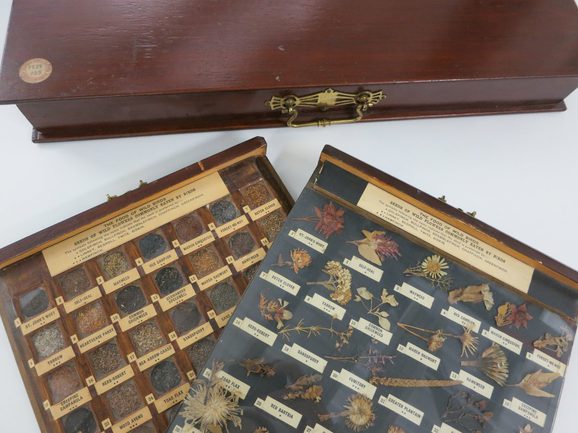
A case displaying the seeds & plants eaten by British finches. Museum reference Z.1929.143.
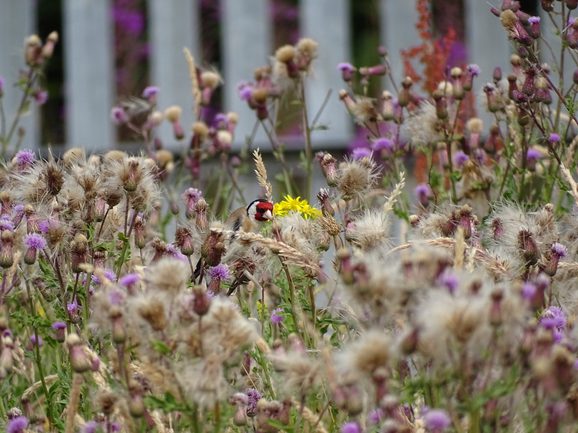
A Goldfinch feasting on thistle seeds at the National Museums Collection Centre.
Even small changes can deliver huge rewards for local biodiversity. Whether that’s joining the No Mow movement, avoiding harmful herbicides and pesticides, litter picking, or contributing to community science projects – we can all do something to support our urban wildlife.
